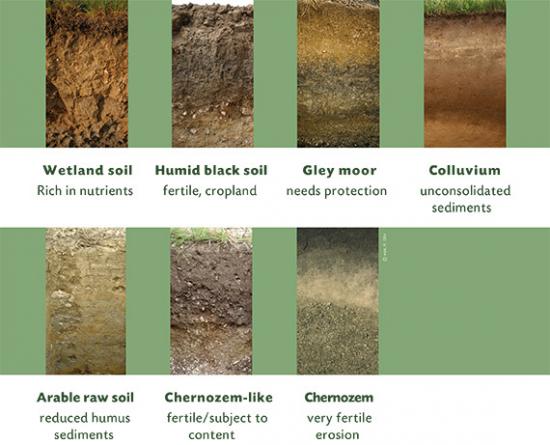Lassee Edible Landscape
SOILS - SKIN OF OUR EARTH
"Soils are the live uppermost section of the upper part of the earth's crust. They range from several centimetres to several tens of metres in thickness compared to a thickness of the earth's crust of 5 to 40 kilometres."
"Soils belong to the most precious and, hence, most protection-worthy goods of mankind."
Agricultural district authority and the municipality of Lassee.
Agriculture Textbook: "Lehrbuch der Bodenkunde", Scheffer/Schachtschabel 2016
The 7 types of soil in the district of Gänserndorf

Soils cannot be multiplied.
It takes at least one hundred years for one centimetre of soil to develop from rock through decomposition processes. Biomass that dies in winter and decays is responsible for constant humus formation. The fertile soils of Central Europe were formed after previous ice ages, the last of which ended approximately 12,000 years ago. This means that our soils are between 5,000 and 150,000 years old. Thanks to their humus and mineral content, they are fertile and provide the foundation for agriculture. The tropics are home to the oldest soils of our planet, which are between 70 and 80 million years of age. Over the course of millions of years, their minerals have been washed into the oceans via rivers, making them salty as a result. Because of the warm climate, the nutrients form part of a continuous cycle. If the trees and shrubs are subject to extensive felling, the ground will become fallow und be swept away by the wind or washed out by rainfalls. A similar result occurs in our case if soils are rendered fallow due to radical felling and frequent ploughing. The slowly established fertility of the soils will then, within a very short time, be lost due to wind erosion and heavy rainfalls. Only a richly structured landscape with hedges, groups of trees, and field and meadow margins can counteract this effect.
The soil is alive.
A large variety of soil organisms maintains life on the earth's surface. They control and regulate entire ecosystems by processing accruing organic substance and hence supplying plant nutrients such as nitrogen and carbon for the material lifecycle. Microorganisms also help to improve the soil structure and make sure that humus-rich soil can develop, as well as the resulting plants and landscapes. A layer of 5 centimetres of grassland soil can house up to 250 kilograms of fungal mycelia per hectare and up to 10,000 different species.

26.09.2024
555 x Paradies-Genüsse - Obstvielfalt entdecken und schmecken
mehr ...24.+25.09.2024
31th Conferece of the Danube Region
mehr ...21.09.2024
Fest der Obstvielfalt im Alchemistenpark
mehr ...13.-15.09.2024
Mein Beeren- und Obstparadies
mehr ...11.-13.09.2024
Tropentag 2024
mehr ...06.-09.2024
ernte.dank.festival. am Wiener Heldenplatz
mehr ...15.+16.05.2024
Bodenforum Österreich - Frühjahrstreffen 2024
mehr ...20.-21.04.2024
Joel Salatin - Masterclass-Seminar Weidemanagement
mehr ...16.04.2024
Exkursion Mehrnutzungshecken
mehr ...12.04.2024
Dialog Zukunft Pflanzenbau: Runder Tisch - EU Richtlinie zur Bodenüberwachung und -resilienz
mehr ...12.04.2024
Online-Workshop Boden und Klima - Ganzheitliches Wassermanagement in Stadt und Land
mehr ...03.04., 04.04., 23.04.2024
Flexibles Begrünungsmanagement im Wein- und Obstbau
mehr ...27.-29.03.2024
Mein Beeren- und Obstparadies
mehr ...20.03., 21.03., 03.04., 04.04., 23.04.2024
Flexibles Begrünungsmanagement im Wein- und Obstbau
mehr ...20.03.2024
Obstbaumschnittkurs für langlebige und gesunde Bäume "Stummelschnitt ade"
mehr ...12.-14.03.2024
Vortrag: "Die Essbare Stadt, Geeignete Obstbaumarten für den Urbanen Raum"
mehr ...13.03.2024
Carbon Farming, wofür und für wen? - Hybridveranstaltung
mehr ...12.03.2024
Zertifikatslehrgang Bodenpraktiker Ackerbau 2024
mehr ...09.03.2024
Stummelschnitt ade - Obstbaumschnittkurs für langlebige und gesunde Obstbäume
mehr ...05.03.2024
Exkursion Mehrnutzungshecken
mehr ...


